[Retracted] The Study about Relationship of Direct Form of Topological Indices via M-Polynomial and Computational Analysis of Dexamethasone
Abstract
Nowadays, all scientists are in the race to find a cure for COVID-19. This is a viral disease that is due to severe acute respiratory syndrome coronavirus 2 (SARS-CoV-2). Different antiviral drugs are under investigation. Dexamethasone is being used for the treatment of COVID-19. In this article, the chemical structure of dexamethasone is explored using computational techniques such as topological indices. Proofs of a few closed formulas that describe the degree-dependent topological indices calculated from the M-polynomial of the graphs are also given in this article.
1. Introduction
Epidemics such as flu, cholera, and plague disturb the life of the people of the world for centuries. COVID-19 began in China on December 19 and has since claimed many lives and is responsible for the largest global recession. This is due to the virus named severe acute respiratory syndrome coronavirus 2 (SARS-CoV-2) [1, 2]. The spread of this virus can be reduced by using personal protective equipment and physical distance. The search for a cure to prevent COVID-19 is an important need of today.
Different techniques such as antiviral drugs, vaccines, and plasma therapy are under progress to control this viral disease [3]. So far, no effective medicine has been developed to treat patients with COVID-19. Several clinical trials have been conducted to study the effect of different drugs on patients [4]. The results of the dexamethasone on patients with COVID-19 are encouraging [5, 6]. Dexamethasone is a corticosteroid that is used for its immunosuppressant and anti-inflammatory properties. The chemical formula of dexamethasone is C22H29FO5 and also known as 9α-fluoro-11β, 17α, 21-trihydroxy-16α-methylpregna-1,4-diene-3,20-dione. Dexamethasone is white to off-white crystalline powder. It has a slightly bitter taste and is odorless. 3D and 2D structures of dexamethasone are shown in Figure 1.
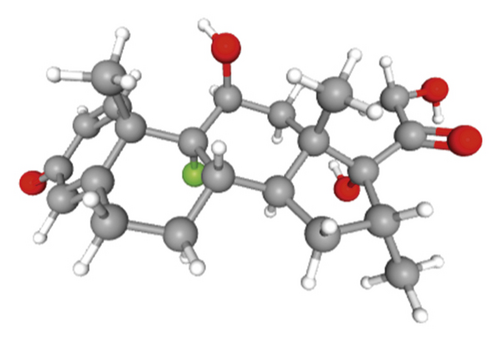
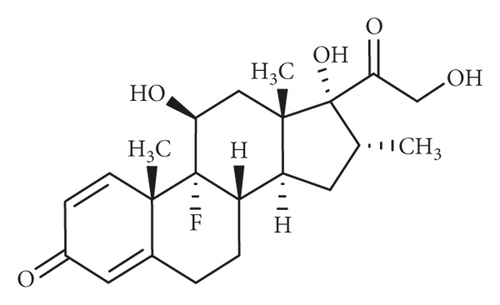
A graph is represented with G(VG, EG) where VG and EG have represented the vertex set and edge set, respectively. The number of edges that meet at a vertex x is called the degree of a vertex (dx). The graphical form of the structure of the chemical compound is known as a chemical graph. In a chemical graph, atoms behave as vertex and bonds as edges. This graph is a valuable source of the physical and chemical properties of the substance. Computational analysis of the chemical graph has been studied in chemical graph theory. C-H bond does not have a serious effect on the characteristics of the chemical species. So, during the computational analysis, we ignore it.
Shin et al. [25] presented the closed form of topological indices via M-polynomial, but they are not provided the relationship between them. In the following section, we provide this relationship.
2. Main Results
Theorem 1. Let MG(u, v) be the M-polynomial for the graph G, then the reduced reciprocal index is calculated as .
Proof. By taking
Hence, .
Theorem 2. If MG(u, v) is the M-polynomial of the graph G, then the first arithmetic-geometric index is given by .
Proof. By taking
Hence, .
Theorem 3. If MG(u, v) is represented the M-polynomial of the graph G, then .
Proof. By taking
Hence, .
Theorem 4. If MG(u, v) is the M-polynomial of the graph G, then .
Proof. By taking
Hence, .
Theorem 5. If MG(u, v) is the M-polynomial of the graph G, then .
Proof. By taking
Hence, .
Theorem 6. Let MG(u, v) be the M-polynomial for the graph G, then .
Proof. By taking
Hence, .
Theorem 7. Let MG(u, v) be the M-polynomial for the graph G, then the sum-connectivity index is given by .
Proof. By taking
Hence, .
Theorem 8. IF MG(u, v) is the M-polynomial of the graph G, then the general sum-connectivity index is given by .
Proof. By taking
Hence, .
Theorem 9. If MG(u, v) is the M-polynomial of the graph G, then the redefined third Zagreb index is also calculated as .
Proof. By taking
Hence, .
3. M-Polynomial of Dexamethasone
The chemical graph of dexamethasone (DM) is shown in Figure 2, in which green, red, pink, and brown dots represent the vertices of degrees 1, 2, 3, and 4, respectively; cyan, orange, yellow, purple, blue, black, gray, violet, and magenta edges represent the edges having the degree of end-vertices (1,2), (1,3), (1,4), (2,2), (2,3), (2,4), (3,3), (3,4), and (4,4), respectively. In this present work, we extract some topological indices via M-polynomial of (DM).
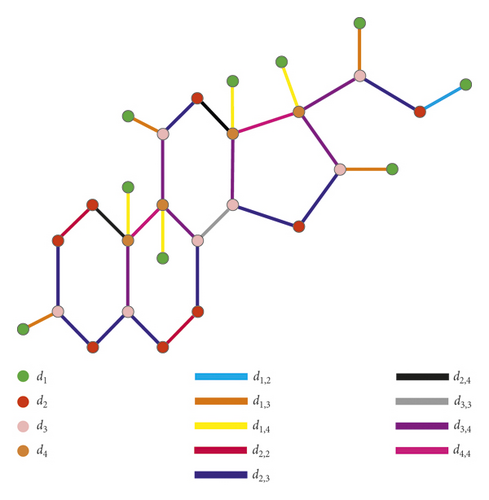
Theorem 10. Let DM be dexamethasone, then M-polynomial of DM is .
Proof. Let DM represent the dexamethasone, then by using Figures 1 and 2 and Table 1, we have that there are four partitions of the vertex set with respect to the vertex degree defined as where n = 1,2,3,4.
Figures 1 and 2 and Table 2 show that there are nine partitions of the edge set with respect to the degree of end-vertices of the edge. These partitions are represented with En, where where n = 1,2,3, …, 9 and a, b = 1,2,3,4 with a ≤ b. We have the following result by using the definition of M-polynomial:
The plot of the M-polynomial of DM is shown in Figure 3.
| dx | 1 | 2 | 3 | 4 |
|---|---|---|---|---|
| Number of vertices | 9 | 8 | 7 | 4 |
| (dx, dy) | (1,2) | (1,3) | (1,4) | (2,2) | (2,3) | (2,4) | (3,3) | (3,4) | (4,4) |
|---|---|---|---|---|---|---|---|---|---|
| Number of edges | 1 | 4 | 4 | 2 | 9 | 2 | 1 | 6 | 2 |
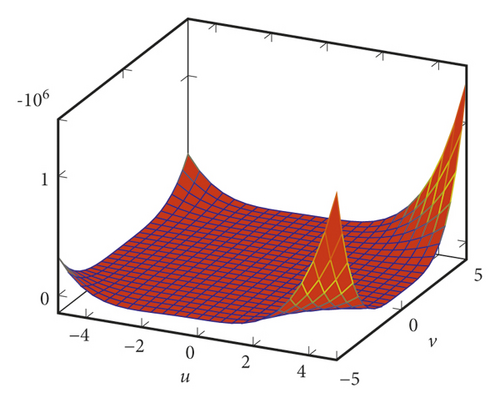
4. Topological Indices of Dexamethasone
Theorem 11. Let DM represent the dexamethasone and
- (1)
- (2)
- (3)
SK[DM] = 84
- (4)
SK1[DM] = (221/2)
- (5)
SK2[DM] = 240
- (6)
EM1[DM] = 412
- (7)
- (8)
SCIλ[DM] = 3λ + 6 · 4λ + 13 · 5λ + 3 · 6λ + 6 · 7λ + 2 · 8λ
- (9)
ReZG3[DM] = 1346
Proof.
- (1)
- (2)
- (3)
- (4)
- (5)
- (6)
- (7)
- (8)
- (9)
The results of topological indices are plotted in Figure 4.
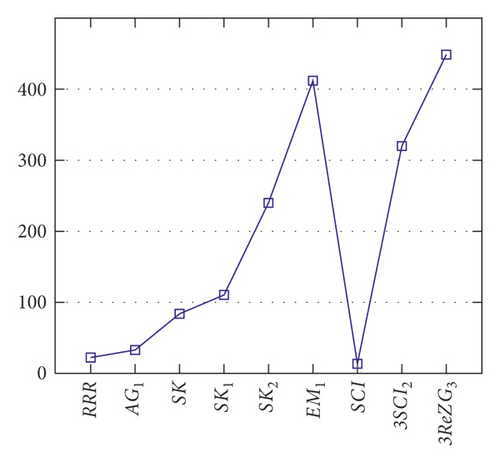
5. Conclusion
We have presented the proofs of the formulas of some topological indices, which are derived from M-polynomial. The structure of the molecule can explore the chemical and biological behavior of the chemical compound. In the present work, we gave the computational analysis of the dexamethasone used during the treatment of COVID-19 by finding the topological indices. These topological indices are calculated from the M-polynomial of dexamethasone.
Conflicts of Interest
The authors declare that there are no conflicts of interest regarding the publication of this paper.
Open Research
Data Availability
No data were used in this research.




